
Dogs typically have litters consisting of fraternal multiples. These result from multiple eggs being fertilized by one sperm each. The sperm can all be from the same sire, or different eggs can get fertilized by sperm from different dogs. The puppies resulting from the former are fraternals - they are full brother and sister but are no more closely related genetically than they are to older siblings from previous litters from the same parents. Pups resulting from eggs fertilized by different sires will be half siblings since they share the same mother but have different sires.
Occasionally, an embryo will split into two separate embryos early in development and give rise to two genetically identical individuals. Identical twins (monozygotic twins) have been observed in humans and occasionally in Holstein cattle. These twins have the same genes and maternal prenatal conditions. They share the same placenta and amniotic sac. There has been a lot of speculation on just how similar the amount and placement of white markings would be and how similar the merle pattern would be on identical twin puppies.
Aussie breeder Linda Holbrook of Eldorado Australian Shepherds has provided us with a rare opportunity to observe this. In Feb 2000 her bitch gave birth to a litter that included a pair of identical twin female merle puppies. In her photos below, we can see the similarities between them. They are not exactly the same hair for hair, but they are very very close. They have similar amounts and placement of white markings. Their merle patterns are quite similar, even to the split face on the forehead. This, combined with the fact that the nonidentical siblings of the litter vary considerably, would suggest a genetic component to the distribution of merling and the details of the white markings. It would also suggest a hereditary component to the tendency of the merle pattern to split down the midline of the face. Many thanks to Linda for sharing the photos and information on this twinning event. This page will continue to be updated as more information becomes available.
Note: There have been cases in which two puppies appeared to share a placenta but had separate amniotic sacs. In one such case the two puppies were of opposite sex, clearly not identical twins. Probably their two placentas were so close together that they fused in development.

These identical twin girls are only a few days old. One is slightly larger, but that may well even out over time. Their blazes are similar in size and coverage, and both have split faces with the black on their left foreheads. It will be interesting to compare eye color when their eyes open to see if blue or flecks of blue are similar in placement (assuming their eyes have any blue - not all merles do).
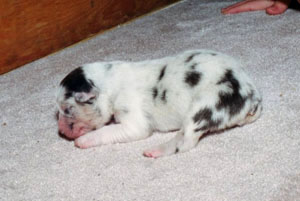
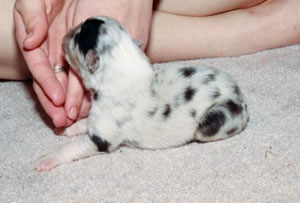
These are left side shots of both twins. Notice the black spotting on the hips and sides of the body. The placement is not exactly the same, but it is very close in terms of size of spots and general body distribution. The twin on the right has a nice black spot on the left foreleg. It is possible that the twin on the left would as well if that area were not covered by white. White markings are like white paint in that they hide the true color underneath them. Even so, these girls are remarkably similar in appearance. It will be interesting to find out as they continue to develop how similar their temperaments are.
The twins are now 4 weeks old. Linda reports that they have remarkably similar temperaments and that they are the first two of the litter to arrive at the side of the whelping box when someone comes in to see them. Their 4 week pictures are below. Notice also how their noses, mostly pink shortly after birth, have filled in considerably with black pigment after only 4 weeks!
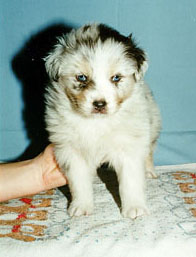
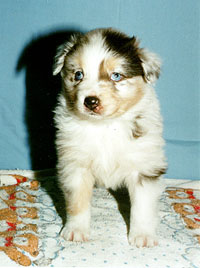
Tiffy is the pup on the left, and Heidi is the one on the right. Their faces are still remarkably similar. Both show the partial split faces, visible on their foreheads. The exact placement of black in their split faces varies slightly, but in total amount it is similar. It looks as if both will have blue eyes; those irises are very light.

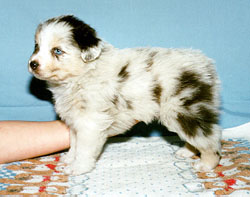
Looking at their left side views, the general pattern of black is similar. They both show scattered spots on the forequarters and body to the rear of the ribs. Their haunches have heavier marbling. The shade of blue looks also very similar, but it appears that Tiffy on the left has darker tan points than Heidi, at least on the face, and possibly on the rear foot as well.

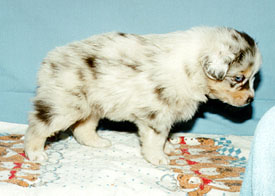
Interestingly, the right side view gives a different picture. The tan points on the faces appear to be similar in shade. The merle patterns are not exactly the same; Tiffy has a somewhat large black area on her side, while Heidi's is on her rear leg. But if you were to shave the hair of each pup and sort the blue hair into one pile and the black hair into another pile for each pup, the two would probably have very similar ratios by weight of blue hair to black hair. At 4 weeks they are developing similarly in personality and nose pigmentation. Their general pattern of merling is similar, as is their shade of blue. There are some minor differences in exact placement of black splotches and of white trim.
 |
 |
|
 |
 |
 |
© 1999-2009 Lisa McDonald Comments